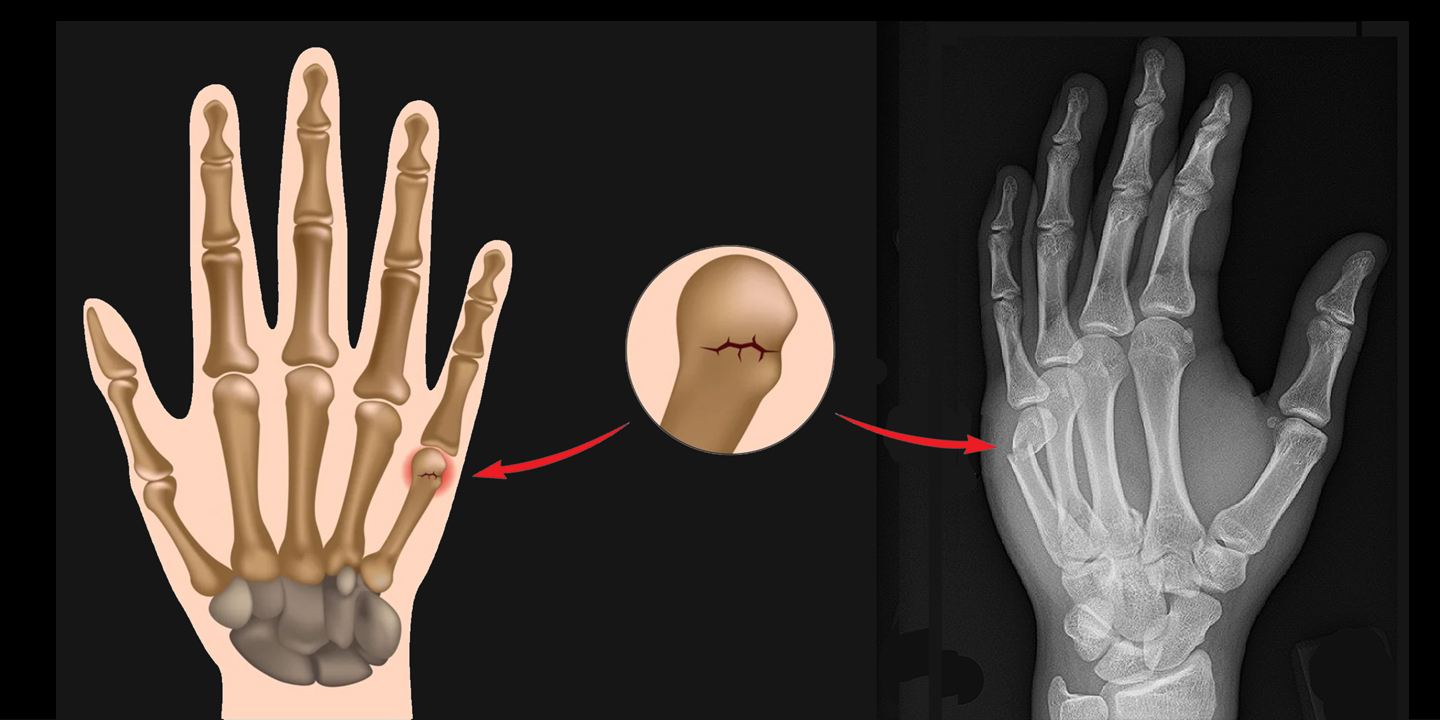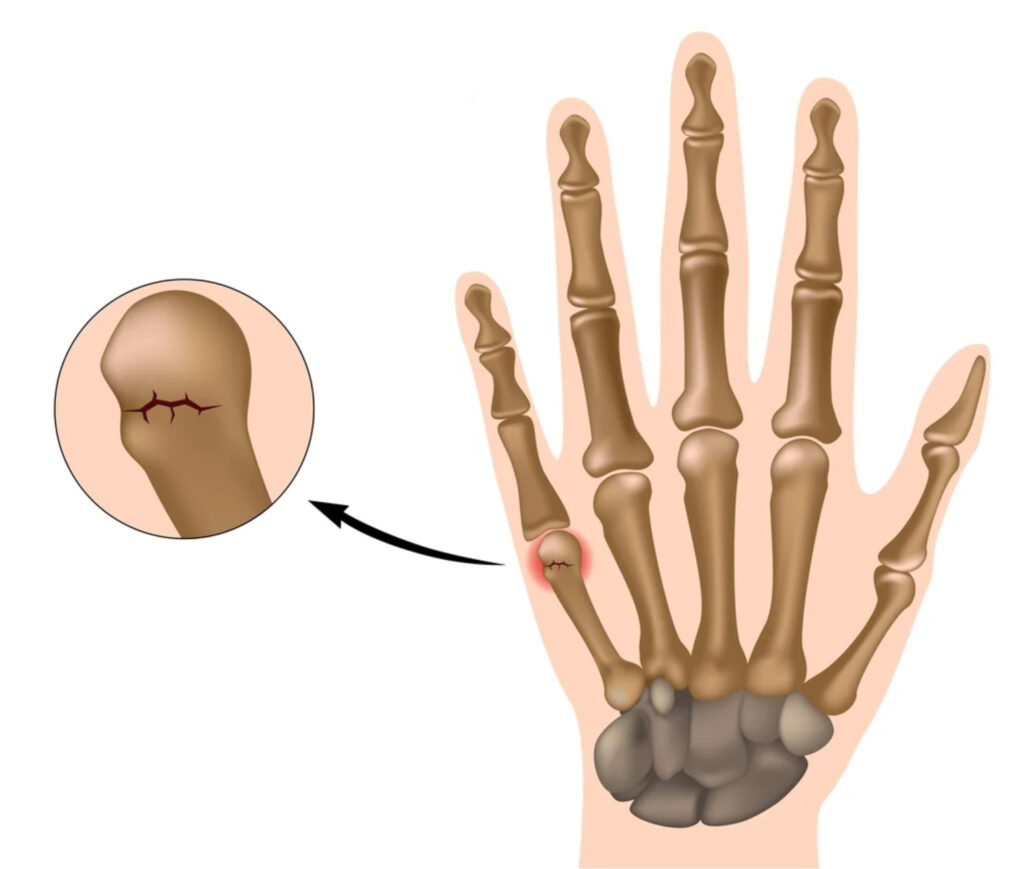
Academy Menu
Supplemental Lessons
The Boxer's Fracture
A Common Injury in Lethwei

Overview
The human hand consists of a complex arrangement of bones that form the skeletal framework for its functionality. There are 27 bones in the human hand, divided into three main groups: the carpal bones, the metacarpal bones, and the phalanges. There are eight carpal bones, which are arranged in two rows of four each. The carpal bones provide stability and support to the wrist joint and allow for a wide range of wrist movements. There are five metacarpal bones, one for each of the five fingers. They are numbered I (thumb) through V (pinky) and are situated between the carpal bones and the phalanges. Metacarpals form the palm of the hand and serve as a connection between the wrist and the fingers. Each finger (except the thumb) consists of three phalanges: the proximal phalanx, the middle phalanx, and the distal phalanx. The thumb has only two phalanges: the proximal and distal phalanges. These bones allow for the flexion and extension of the fingers and contribute to the hand’s dexterity and ability to grasp objects.
The arrangement of these bones, along with the surrounding ligaments, tendons, and muscles, enables the hand to perform a wide range of intricate movements and functions, making it a remarkable tool for tasks such as gripping, manipulating objects, and performing fine motor skills.

A Boxer’s Fracture is a type of fracture that can occur when the fifth metacarpal bone in the hand, which connects to the pinky finger, breaks. It can occur when an individual clenches their fist and strikes a hard surface such as the human skull with significant force. The impact transfers energy to the metacarpal bones, which are the long bones in the hand that connect the fingers to the wrist. The force can cause one or more of these bones to break. The Boxer’s Fracture is a common injury in the bare-fisted fighting of Lethwei.
Symptoms
There are a number of common symptoms that indicate that a Boxer’s Fracture has occurred. The most common symptom of a boxer’s fracture is severe pain at the site of the injury, typically in the knuckles or the back of the hand. Swelling and bruising may also accompany the fracture due to tissue damage and inflammation. In some cases, the fracture may cause a noticeable deformity with the knuckle appearing sunken or the finger deviating from its normal alignment. Individuals with a boxer’s fracture may also find it challenging to move the affected finger or grip objects. In some cases, damage to nerves in the hand can lead to numbness or tingling sensations.
An individual who believes they have experienced a Boxer’s Fracture should seek treatment to prevent further damage to the hand. A doctor will assess the injury through physical examination and may order X-rays to confirm the diagnosis. If a Boxer’s Fracture is established by the medical evaluation, in most cases, the treatment will involve immobilizing the affected hand and wrist. This is typically achieved by placing the hand in a cast or splint to allow the fracture to heal properly. In severe cases or if the bones are significantly displaced, surgical intervention may be necessary to realign and stabilize the fractured bones. Once the fracture has healed, physical therapy may be recommended to improve hand strength and flexibility. Only after receiving a doctor’s approval should the individual recommence combat sports training.

Treatment
When someone suspects a boxer’s fracture, they should seek immediate medical attention. A doctor will assess the injury through physical examination and may order X-rays to confirm the diagnosis. In most cases, the treatment involves immobilizing the affected hand and wrist. This is typically achieved by placing the hand in a cast or splint to allow the fracture to heal properly. Pain relief may be provided through over-the-counter or prescription medications as recommended by the healthcare provider. After the fracture has healed, physical therapy may be recommended to improve hand strength and flexibility. In severe cases or if the bones are significantly displaced, surgical intervention may be necessary to realign and stabilize the fractured bones.
Prevention
Wear hand wraps and boxing gloves. When wearing boxing gloves, make sure to wrap your hands properly with hand wraps. This helps stabilize the wrist and provides additional protection to the bones and joints in your hand. Well-fitted boxing gloves can absorb and distribute the force of impact, reducing the risk of fractures. Learn and practice proper punching techniques. Proper form can reduce the stress on the hand and minimize the risk of injury. If you’re new to boxing or martial arts, consider working with a qualified coach who can teach you proper technique and provide guidance on injury prevention. Be mindful of the amount of force you use when striking objects. Hitting a hard surface with excessive force can increase the risk of a Boxer’s fracture. Use controlled and precise punches instead of wild and uncontrolled swings.
Strengthen your hands, wrists, and forearm muscles through exercises specifically designed to improve hand strength and stability. This can include grip strengthening exercises and wrist curls. Stretch and maintain flexibility in your hands and wrists. Flexible joints are less prone to injury. Give your hands adequate time to rest and recover between intense training sessions or competitions. Overuse and fatigue can increase the risk of injury.
If you experience any pain or discomfort in your hand after a training session or competition, seek medical attention promptly. Early diagnosis and treatment can prevent a minor injury from worsening. A boxer’s fracture is a painful and potentially debilitating injury that can result from high-impact blows to the hand. Prompt medical attention, immobilization, and rehabilitation are key to successful recovery. Preventive measures, such as using hand protection and proper technique, can significantly reduce the risk of experiencing a boxer’s fracture, emphasizing the importance of safety and caution in activities that involve hand impacts.
Thut Ti Lethwei Global Academy Disclaimer
The information provided on Thut Ti Lethwei Global Academy (lethwei.net) is intended for general informational and educational purposes only. The content on this Website is not intended as a substitute for instruction or direction from a professional combat sports coach or martial arts instructor. The content is also not intended as a substitute for medical direction, advice, diagnosis, or treatment from a health care professional. Always seek the advice of your physician or other qualified health provider with any questions you may have regarding a medical condition or th e safety of participating in any physical activity.
Not Medical Advice: The content on this Website is not intended to be a substitute for professional medical advice, diagnosis, or treatment. Always seek the advice of your physician or other qualified health provider with any questions you may have regarding a medical condition.
Consult a Professional: It is essential to consult with a healthcare professional before starting any new activity program, diet, or exercise routine. Your individual training goals should be discussed with a qualified healthcare provider who can provide personalized recommendations.
Assumption of Risk: Participation in physical activity and exercise carries inherent risks, and by using the information provided on this Website, you acknowledge and voluntarily assume these risks. Always exercise caution and common sense when engaging in physical activities.
Accuracy of Information: While we strive to provide accurate and up-to-date information, the content on this Website may not always reflect the most current research or medical guidelines. We do not guarantee the accuracy, completeness, or timeliness of the information presented.
Responsibility: You are responsible for your health and safety when engaging in any combat sport, martial art, or fitness program, individual exercise, or dietary practice discussed on this Website. Thut Ti Lethwei Global Academy, its authors, contributors, and affiliates disclaim any liability for any injury, loss, or damage incurred as a result of the use or reliance on the information provided on this Website.
Changes to Disclaimer: Thut Ti Lethwei Global Academy reserves the right to modify or update this disclaimer at any time without prior notice. It is your responsibility to review this disclaimer periodically for any changes.
By using Thut Ti Lethwei Global Academy website, you agree to the terms of this disclaimer. If you do not agree with these terms, please refrain from using this website.
